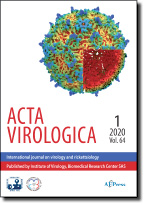Acta Virologica Vol.52, No.4, p.243-249, 2008
|
| Title: Immunological properties of a fusion protein containing nucleocapsid protein and glycoprotein Gn of Hantaan virus |
| Author: W. Luo, F. Zhang, Y. Yan, X. Wu, Y. Liu, W. Bai, Q. Zhao, H. Wang, Z. Xu |
|
| Abstract: Escherichia coli and the baculovirus Bac-to-Bac system were used to express chimeric gene GnS0.7 consisting of glycoprotein Gn gene and the 0.7 kb fragment of S genome segment carrying nucleoprotein (N) gene of Hantaan virus (HTNV). The expressed fusion protein GnN0.7 was recognized by monoclonal antibodies (MAbs) to HTNV Gn glycoprotein and N protein, respectively. Its molecular mass as determined by Western blot analysis corresponded to the predicted value. The mice immunized with insect Spodoptera frugiperda (Sf9) cells transfected with recombinant baculovirus carrying GnS0.7 gene, produced serum antibodies with titer up to 3,200 as assayed by immunofluorescence. Moreover, immunized mice showed positive proliferation index for splenocytes stimulated with HTNV Gn and N, respectively. These results indicated that insect Sf9 cells infected with the recombinant baculovirus expressed a fully biologically active fusion protein that elicited not only humoral but also cellular immune response in mice. Hence, this protein may be used as a genetically engineered subunit HTNV vaccine representing efficacious and safe alternative to traditional vaccines.
|
|
| Keywords: Hantaan virus; fusion protein; immune response |
| Year: 2008, Volume: 52, Issue: 4 |
Page From: 243, Page To: 249 |
|
|
|
|
Price:
16.80 €
|
|
|
|
|
|
|
|

